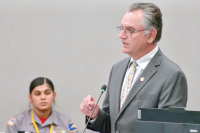MST birthday weekend logs 2,700 miles
An initial tally shows that 434 hikers cumulatively covered 2,756 miles of the Mountains-to-Sea Trail during its birthday weekend Sept. 7 to 9, an average of 6.4 miles per hiker.
MST sees fundraising success
Friends of the Mountains-to-Sea Trail surpassed its fundraising goal of $200,000 to bring in $274,838 through its 40th anniversary campaign.
Embracing the season: Cross-state trek presents challenge and reward for Asheville hiking legend
At 34, Jennifer Pharr Davis has conquered her fair share of long-distance hikes, and then some. Her 2011 hike of the Appalachian Trail set a speed record that stood until 2015. She’s completed the Pacific Crest Trail, the Bartram Trail, the Colorado Trail and a seemingly endless list of other trails scattered across six continents.
But in some ways, her 2017 hike of the North Carolina Mountains-to-Sea Trail was the most challenging — and most rewarding — of all the routes she’s walked.
Becoming a trail town: Sylva embraces the Mountains-to-Sea Trail
White dots will soon pepper the sidewalks of downtown Sylva as the town sets out to claim its identity as a trail town and mark the official route of the Mountains-to-Sea Trail, which runs through Sylva on its way from Clingmans Dome to the Outer Banks.
The trail traverses the state of North Carolina, offering a walking route 1,175 miles long that, true to its name, takes hikers from the state’s highest mountains to its interface with the sea. And a section of the trail travels right through downtown Sylva, something that Sylva attorney and Friends of the MST board member Jay Coward is urging town leaders to capitalize on. He also has plans to speak to the Dillsboro Board of Aldermen.
From mountains to sea: N.C. woman relives six months spent hiking the state
If you’d polled Kimberley Brookshire’s friends a couple years ago, they’d likely have said the chances were slim to none that the Charlotte resident would ever think seriously about leaving it all behind to hike more than 2,000 miles through North Carolina.
“I wasn’t much of an outdoors person,” said Brookshire, 32.
America’s Great Outdoors Initiative
Recreation, conservation and preservation-minded environmentalists from all over Western North Carolina streamed into the Ferguson Auditorium at Asheville-Buncombe Technical College for a chance to influence federal policy.
“They’re calling it a listening session,” said Abe Nail, 56, of Globe. “I can’t imagine the Bush administration doing anything like that.”
Judi Parker, 63, also of Globe –– which is tucked into the middle of the Pisgah National Forest just south of Blowing Rock –– marveled at the crowd of people swarming around her.
“I’m just glad so many people came,” she said.
Nail and Parker were two of more than 500 people who came to participate in a project inaugurated by President Barack Obama in April. Administration officials from the U.S. Fish and Wildlife Service, the U.S. Forest Service, and the Department of Interior –– all of which have a stake in overseeing America’s public lands –– have joined together for a road show to listen to the people their policies impact.
Paul Carlson, executive director of the Land Trust for the Little Tennessee based in Franklin, said the administration’s willingness to send senior officials to the listening sessions showed it was serious about supporting locally-based conservation efforts.
“Those are pretty senior guys and for them to be out there taking that kind of time to listen to us is pretty impressive,” Carlson said.
The group has toured a dozen cities already to meet with stakeholder groups and talk about how the federal government can do a better job expanding access to outdoor recreation and land conservation in everything from city parks to national forests.
Will Shafroth, Deputy Assistant Secretary of Interior, is one of a handful of officials who have been to every city so far. Shafroth said the trip has given him a lift during a trying period.
“It’s invigorating because with the dark cloud of the oil spill in the Gulf, which has been a real drag on our sense of what’s happening, you come into a place like this and it’s just full of energy,” Shafroth said.
The strain of the past months showed on Shafroth’s face, and during his opening remarks he managed to forget where he was, thanking the people of “Asheville, Tennessee” for the turnout.
Asheville Mayor Terry Bellamy handled the slip graciously and led the audience –– which was made up of a wide range of characters from AmeriCorps volunteers to non-profit executive directors to local politicians –– in a rousing call and response that confirmed the real venue for the event.
The value of the listening session as a policy tool may not yet be determined, but its worth as a morale building exercise was evident from the start.
Tom Strickland, Assistant Secretary for Fish and Wildlife and Parks, invoked the legacy of Teddy Roosevelt in his remarks and set the tone for the dialogue later in the day.
“We know now that the solutions are not going to come from Washington, if they ever did,” Strickland said.
The room buzzed as Julie Judkins of the Appalachian Trail Conservancy, a facilitator in the morning’s youth event, offered some feedback direct from the young people to the big bosses.
“Even though we love Smoky [the Bear], maybe it’s time to get him on the iPhone,” Judkins said.
John Jarvis, head of the National Park Service, offered a succinct summation of the aim of the event in his address.
“We need your ideas so we can spread them around to other parts of the country,” Jarvis said.
The listening sessions have been organized to inform a report that will be on President Barack Obama’s desk by November 15. After the hour-long introductory session that included an eight-minute inspirational video invoking the nation’s relationship with its public lands, the participants headed to breakout sessions in classroom settings to discuss their own experiences.
The sessions were organized to record what strategies were working, what challenges organizations were facing, how the federal government could better facilitate change, and what existing tools could be used to create improvements in the system.
In a breakout session focused on outdoor recreation, participants affiliated with trail clubs, mountain biking groups, paddling groups, tourism offices and scout troops piled into a room.
Mark Singleton, executive director of Sylva-based American Whitewater, participated in the president’s kickoff conference in Washington, D.C., back in April. Two months later he was telling the facilitator that the government had to work to create better and more accessible options for recreation on public land so the younger generation would grow up with a conservation ethic.
“It’s hard to protect something if you don’t love it,” Singleton said. “There can’t be a disconnect with the younger generation.”
Eric Woolridge, the Wautauga County Tourism and Development Authority’s outdoor recreation planner, hailed the new cooperative model in Boone that uses a local tax on overnight lodging to fund outdoor recreation infrastructure projects.
Woolridge oversees an outdoor recreation infrastructure budget of $250,000 derived from proceeds of a 6 percent occupancy tax.
“The key is that we have a revenue stream, and it always stays there,” Woolridge said.
There were specific asks for cooperation from the Feds, too. A woman from North Georgia wanted to know how to get memorandums of understanding with various agencies to help her youth orienteering program.
Don Walton, a board member with the Friends of the Mountain To Sea Trail, asked that the U.S. Park Service to consider allowing more camping opportunities on land owned by the Blue Ridge Parkway.
While each set of stakeholders had their own pet issues, nearly everyone was urging the Feds to ramp up their contribution to the Land And Water Conservation Fund, which uses revenues from off-shore oil leases to benefit outdoor recreation projects across the country.
Secretary of Interior Ken Salazar authorized $38 million for state projects through the fund this year, but the administration has announced its aim to authorize the full funding level of $900 million for the LWCF by 2014.
Woolridge, Singleton and many other outdoor recreation stakeholders also waned to emphasize that their work isn’t just about playing, it’s about economic development.
“Outdoor recreation and conservation is a legitimate development strategy,” Woolridge said. “In fact, it may be the only development strategy for rural communities.”
For Shafroth, who ran a non-profit in Colorado before taking his job at the Department of Interior, the economic challenges of the moment are an ever-present reality.
“With the shortfalls with resources we have right now and the size of people’s goals… in some cases, there’s a pretty big gulf right now,” Shafroth said.
But more than just dollars and cents, the listening tour is an organizing effort, a way to get conservation-minded people in front of their government to start a long-overdue conversation.
Abe Nail said his attendance at the event wasn’t about money.
“You can’t buy conservation. Conservation is passion driven,” Nail said.
To submit comments online to the America’s Great Outdoors Initiative, visit http://ideas.usda.gov/ago/ideas.nsf or email This email address is being protected from spambots. You need JavaScript enabled to view it..
Iconoclast hiker conquers Mountains to Sea Trail
Scot Ward isn’t a missionary, but he does have a burning message. An experienced thru-hiker who carries a copy of Peter Jenkins Walk Across America in the retrofitted box-truck he calls home, Ward wants people to hike the Mountains to Sea Trail for exactly the reason they aren’t doing it now.
“It shows you everything the state has to offer. On the Appalachian Trail, you see the woods no matter where you are,” Ward said.
The nearly 1,000-mile Mountains to Sea Trail runs across North Carolina from the Tennessee border to the Outer Banks, but only about 500 miles of footpaths, mostly in the mountains of Western North Carolina, already exist. The rest of the walk involves road hiking, which has prevented the trail from attracting the number of pilgrims it needs to earn a reputation.
Ward believes the Mountains to Sea Trail lays the soul of North Carolina bare to the people that hike it, and he wants to open up that experience to a wider range of people. He recently produced a comprehensive trail guide for the Mountains to Sea Trail on a shoestring budget, and last week he visited Osondu/Blue Ridge Books in Waynesville and City Lights Books in Sylva to push his product.
While there are other trail guides out there, Ward’s 100-page version is accurate to the 1/100 of a mile and obsessively lists information like water resources, fire locations, campsites, and food options. None of the other trail guides have dealt with the actual details of thru-hiking the Mountains to Sea Trail in this kind of detail.
The 35-year-old self-described nomad was living in Hawaii when he heard about the Mountains to Sea Trail and decided he had to see it for himself. Having hiked the Appalachian Trail in 2003, the Long Trail in 2004, and the Colorado Trail in 2005, he was looking for another challenge.
“I’m trying to answer the question that every thru-hiker on the AT asks when they peak Mt. Katahdin,” Ward said. “What now?”
Ward hiked the Mountains to Sea Trail for the first time in 2007. Last year he became the first person known to have “yo-yo’d” the trail. He walked it eastbound from Clingman’s Dome to Jockey’s Ridge State Park, then turned around and walked the 965 miles back.
The purpose of the trip was two-fold. For a hiker who goes by the trail name “T.A.B.A” (short for There and Back Again), the mission held a special kind of satisfaction. But more importantly, Ward’s first experience as an out-of-state hiker on the Mountains to Sea Trail showed him clearly why more people weren’t thru-king it.
“If you want to bring people to the trail to hike it, then you have to have places for them to sleep,” said Ward.
Ward set out to fix that problem by figuring out a way to hike the trail and sleep on it. Along the way he convinced 20 churches and eight businesses along the road portion of the trail through the Piedmont to agree to allow hikers to camp on their property.
Still, overnight camping is prohibited on much of the public land on the trail –– including the portions that follow the Blue Ridge Parkway and some of the state parks.
Ward drew the ire of some Mountains to Sea Trail advocates when he posted the best ways to camp illegally on his Web site last year.
“I’m not trying to start trouble,” Ward said. “I’m trying to fix a problem.”
Ward understands his methods can be misunderstood, but he doesn’t have time for hand-holding.
“I’m the kind of guy that goes the opposite way in a mosh pit,” Ward said.
Scot Ward’s singular spirit can in part be traced to his genes. His grandfather Eddie Ward, a member of the Flying Ward family, performed all of the vine-swinging stunts for the original Tarzan movies starring Johnny Weismuller. In short, he comes from one of America’s most celebrated circus families.
But he owes his traveling bug just as much to his own life experience. His Miami area neighborhood was destroyed by Hurricane Andrew in 1992. A recent high school grad, Ward hopped on his bike and road to New York City. Since then he’s ridden over 40,000 miles of America’s roadways on a bicycle. He’s also been a professional in-line skater, a skydiver, and a limousine driver in Beverly Hills.
Scotty’s World, as he sometimes calls it, isn’t like your world. But he insists anyone can experience what it feels like if they have the courage to get out of their cars and take to the trail.
“Walking and riding a bicycle across America, you’re putting yourself in people’s environment,” Ward said. “You stop at a store and you hang out there, and people start to look at you and then they ask questions. They want to know why you’re there. When you’re in your car, you’re still in your own environment.”
This month, Ward will receive recognition from Friends of the Mountains to Sea Trail for his there-and-back-again hike. He’ll also travel from bookstore to bookstore along the route with his new trail guide.
“Now we’ve just got to get the park service on board to let us camp in the woods,” Ward said.
To learn more about Scot Ward or to find his trail guide go to www.thru-hiker.us. Or to learn more about the Mountains to Sea Trail visit www.ncmst.org.
Day hikes along the Mountains-to-Sea Trail
Balsam Gap Segment
This portion of the trail runs for approximately 35 miles from Blue Ridge Parkway (BRP) Balsam Gap Ranger Station (milepost 442.9) to the intersection of the BRP with NC 215 (BRP milepost 423.2). Abundant wildflowers and shrubs such as rhododendron and azalea and a number of wild berry patches — blueberry, strawberry and blackberry — grow along this scenic section. It harbors northern hardwood and spruce-fir forest bird species including black-billed cuckoo, brown creeper, wild turkey, yellow-bellied sapsucker, and black-capped chickadee. Grassy Ridge Mine, an old mica mine, is visible off Grassy Ridge Overlook at BRP milepost 436.8. Spectacular views of the Great Balsam Mountains and the Tuckasegee River Valley are visible from Double Top Mountain Overlook (BRP milepost 435.3). This segment also offers excellent vantage points for watching the monarch butterfly migration.
Mount Pisgah Segment
Running from NC 215 (BRP milepost 423.2) to the BRP French Broad River Bridge (milepost 393.5) for approximately 39 miles (66 miles if following the alternative Art Loeb Trail, the only loop on the MST at this time), this high-elevation segment follows the Pisgah Ledge through the upper reaches of the Pigeon River watershed to spectacular vistas including views of Devil’s Courthouse. The alternative route, Art Loeb Trail, drops down to the Davidson River before climbing back to Mount Pisgah through the Pink Beds. The trail courses past cascades and waterfalls, conifer groves, thickets of mountain laurel, and tunnels of rhododendrons that are breathtakingly beautiful when their blossoms open in May and June. Wild turkeys and northern bobwhites roam below as common yellowthroats, white-breasted nuthatches, cedar waxwings, several species of warblers, and even a few ruby-throated hummingbirds and golden eagles fly above.
Mount Mitchell Segment
High-country hiking is excellent along this stretch which runs approximately 14.5 miles from Balsam Gap Parking Overlook (BRP milepost 359.8) to U.S. Forest Service Black Mountain Campground. In these spruce-fir forests chances are good for sighting the northern saw-whet owl, pine siskin, red crossbill, veery, downy woodpecker, golden-crowned kinglet, and a number of warblers. Small mammals and white-tailed deer, black bears, bobcats, and gray foxes roam this area. Some of the most spectacular scenery east of the Mississippi includes views of the Asheville Watershed, Potato Knob and Mount Mitchell in the Black Mountain range, and the nearby Great Craggy Mountains. This trail segment also includes a short side trail to the summit of Mount Mitchell, at 6,684 feet the highest point east of the Mississippi River.
(From the Web site http://www.sherpaguides.com/north_carolina/mountains/long_trails/mountains_to_sea_trail.html)
At the helm: New director aims to complete the Mountains to Sea Trail
By Jennifer Garlesky • Staff Writer
The Friends of the Mountains-to-Sea Trail hope its first-ever executive director will be able to complete the missing lengths in the footpath that runs the breadth of the Tar Heel state.





